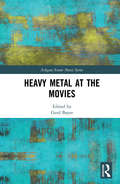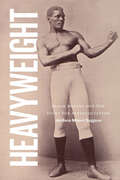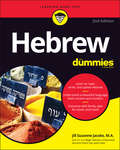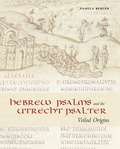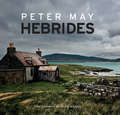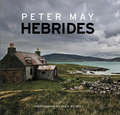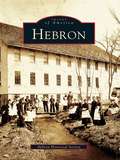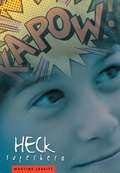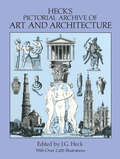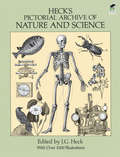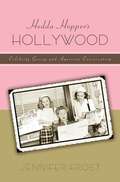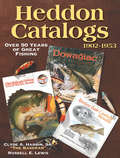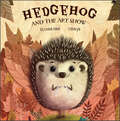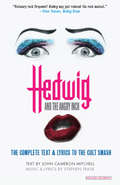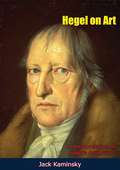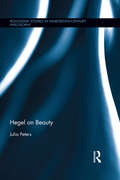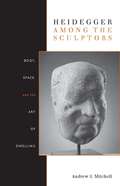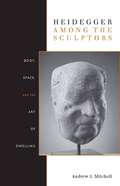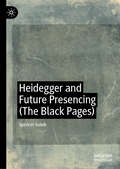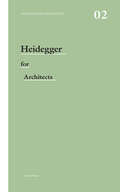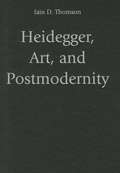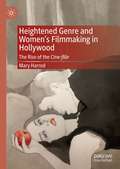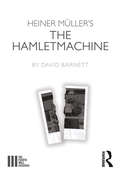- Table View
- List View
Heavy Metal at the Movies (Ashgate Screen Music Series)
by Gerd BayerThe chapters collected in this volume shed light on the areas of interaction between film studies and heavy metal research, exploring how the audio-visual medium of film relates to, builds on and shapes metal culture. At one end of the spectrum, metal music serves as a form of ambient background in horror films that creates an intense and somewhat threatening atmosphere; at the other end, the high level of performativity attached to the metal spectacle is emphasized. Alongside these tendencies, the recent and ongoing wave of metal documentaries has taken off, relying on either satire or hagiography.
Heavyweight: Black Boxers and the Fight for Representation
by Jordana Moore SaggeseIn Heavyweight, Jordana Moore Saggese examines images of Black heavyweight boxers to map the visual terrain of racist ideology in the United States, paying particular attention to the intersecting discourses of Blackness, masculinity, and sport. Looking closely at the “shadow archive” of portrayals across fine art, vernacular imagery, and public media at the turn of the twentieth century, shedemonstrates how the images of boxers reveal the racist stereotypes implicit in them, many of which continue to structure ideas of Black men today. With a focus on both anonymous fighters and notorious champions, including Jack Johnson, Saggese contends that popular images of these men provided white spectators a way to render themselves experts on Blackness and Black masculinity. These images became the blueprint for white conceptions of the Black male body—existing between fear and fantasy, simultaneously an object of desire and an instrument of violence. Reframing boxing as yet another way whiteness establishes the violent mythology of its supremacy, Saggese highlights the role of imagery in normalizing a culture of anti-Blackness.
Hebrew For Dummies
by Jill Suzanne JacobsDiscover Hebrew with the world's most straightforward guide to one of the world's most beautiful languages. Shalom! Are you ready to dive into an ancient-yet-modern and rich language full of nuance? Then open up Hebrew For Dummies and get started learning your way around Hebrew by immersing yourself in its sounds and rhythms. You'll start with the basics—like simple grammar and the Hebrew alphabet—before you move onto commonly used phrases and small-talk. This book gets you used to the more unfamiliar sounds of the Hebrew language—like gutturals—that English speakers aren't used to seeing. It will also help you: Recognize what Hebrew has in common with English (and what it doesn't) Learn to read from right to left, get a handle on the basics of Hebrew grammar, and pick up your first few phrases Discover commonly used expressions that help you get around, shop, eat, and have fun Complete with online resources that help you pick up Hebrew by listening to real speakers have actual conversations, Hebrew For Dummies is the perfect companion to help you work your way towards Hebrew fluency!
Hebrew Psalms and the Utrecht Psalter: Veiled Origins
by Pamela BergerIn a major departure from previous scholarship, this volume argues that the illustrations in the famous and widely influential Utrecht Psalter manuscript were inspired by a late antique Hebrew version of Psalms, rather than a Latin, Christian version of the text.Produced during the early ninth century in a workshop near Reims, France, the Utrecht Psalter is illustrated with pen-and-ink drawings in a lively style reminiscent of Hellenistic art. The motifs are largely literal renditions of words and phrases found in the book of Psalms. However, more than three dozen motifs cannot be explained by either the Latin text that accompanies the imagery or the commentaries of the church fathers. Through a close reading of the Hebrew Psalms, Pamela Berger demonstrates that these motifs can be explained only by the Hebrew text, the Jewish commentary, or Jewish art. Drawing comparisons between the "Hellenistic" style of the Psalter images and the style of late antique Galilean mosaics and using evidence from recent archaeological discoveries, Berger argues that the model for those Psalter illustrations dependent on the Hebrew text was produced in the Galilee.Pioneering and highly persuasive, this book resolves outstanding issues surrounding the origins of one of the most extensively studied illuminated manuscripts. It will be mandatory reading for many historians of medieval art and literature and for those interested in the Hebrew text of the book of Psalms.
Hebrew Psalms and the Utrecht Psalter: Veiled Origins
by Pamela BergerIn a major departure from previous scholarship, this volume argues that the illustrations in the famous and widely influential Utrecht Psalter manuscript were inspired by a late antique Hebrew version of Psalms, rather than a Latin, Christian version of the text.Produced during the early ninth century in a workshop near Reims, France, the Utrecht Psalter is illustrated with pen-and-ink drawings in a lively style reminiscent of Hellenistic art. The motifs are largely literal renditions of words and phrases found in the book of Psalms. However, more than three dozen motifs cannot be explained by either the Latin text that accompanies the imagery or the commentaries of the church fathers. Through a close reading of the Hebrew Psalms, Pamela Berger demonstrates that these motifs can be explained only by the Hebrew text, the Jewish commentary, or Jewish art. Drawing comparisons between the “Hellenistic” style of the Psalter images and the style of late antique Galilean mosaics and using evidence from recent archaeological discoveries, Berger argues that the model for those Psalter illustrations dependent on the Hebrew text was produced in the Galilee.Pioneering and highly persuasive, this book resolves outstanding issues surrounding the origins of one of the most extensively studied illuminated manuscripts. It will be mandatory reading for many historians of medieval art and literature and for those interested in the Hebrew text of the book of Psalms.
Hebrides
by Peter May David WilsonSince the publication of The Blackhouse in 2011, the books of Peter May's groundbreaking Lewis Trilogy have enthralled millions of readers around the world with powerfully evocative descriptions of the Outer Hebrides.From its peat bogs and heather-coated hills, from its weather-beaten churches and crofters cottages to its cold clear rills choked with rainwater, the islands off the northwest coast of Scotland have been brought to vivid life by this accomplished novelist.Now, Peter May and photographer David Wilson present a photographic record of the countless locations around the Hebridean archipelago that so inspired May when he was bringing the islands of detective Fin McLeod's childhood to the page. From the tiny southern island of Barra to the largest and most northern island of Lewis, travel the storm-whipped North Atlantic scenery with May as he once again strolls the wild and breathtaking countryside that gave birth to his masterful trilogy of novels.
Hebrides
by Peter MayThe landscape of the Outer Hebrides, with its stark cliffs, ghostly mists and lonely beaches, has become a definitive character of Peter May's Lewis trilogy. In Hebrides, readers will accompany him on an odyssey in prose and images, through a history of the Vikings' 'Long Island' and his own deep personal connection with the islands that influenced his bestselling work. Travelling as if alongside his protagonist Fin Macleod, he describes the island life - as bewitching as it is treacherous - his encounter with the bird-hunters of Sula Sgeir, the savage seas of Ness and the churches of Eriskay. With extracts from the trilogy and specially commissioned photographs, this book places his writing and characters within the land that gave them form.
Hebron
by Hebron Historical SocietySettled in 1704 and incorporated in 1708, Hebron is one of the oldest towns in Connecticut. Predominantly a farming community for generations, Hebron is also the home of many famous people. Hebron contains pictures of Governor John Peters, Dr. Charles Douglas, author Annie Hutchinson Foote, poet Susan Pendleton, the musically gifted Tennant family, Hebron's turn-of-the-century baseball team, and the Porters, the Hills, the Hildings, and many other lifelong Hebron residents. Hebron was also an industrial center with its own Ams-Sterling automobile, a busy train depot that connected travelers with New York and Boston, silk mills, and cottage industries. This book is the first pictorial history of Hebron ever published and contains many rare photographs from private collections.
Heck Superhero
by Martine LeavittAbandoned by his mother, thirteen-year-old Heck tries to survive on his own as his mind bounces between the superhero character he imagines himself to be and the harsh reality of his life.
Heck's Pictorial Archive of Art and Architecture
by J. G. Heck2,200 illustrations from 19th-century archive include tombs, bridges, temples, mythological and religious figures, Egyptian painting, Greek sculpture, much more.
Heck's Pictorial Archive of Nature and Science: With Over 5,500 Illustrations (Dover Pictorial Archive)
by J. G. HeckBased on J. G. Heck's Bilder Atlas zum Convenations Lexicon, published in German in the nineteenth century, the Iconographic Encyclopaedia of Science, Literature, and Art was a monumental six-volume compilation of illustrations and information, covering an enormous range of subjects, from architecture to zoology. Among its most remarkable features were the thousands of superb steel engravings, comprising one of the most extensive pictorial archives ever published in a single work.The present book, one of three separate and independent volumes based on the rare original American edition of 1851, is devoted to nature and science. Over 170 beautifully reproduced plates contain thousands of illustrations depicting an extraordinary array of subjects: mathematical and geometrical problems; surveying instruments, astronomical maps, and instruments; planetary systems according to Ptolemy, the Egyptians, Copernicus, and others; positions of the planets; botanical illutrations of scores of plants — including seed pods, fruits, and other parts; physical and meteorological illustration demonstrating many laws and principles; numerous types of physical and chemical apparatus; animals, minerals, fossils, geological formations; human anatomy; and many other images. A descriptive table of contents is keyed to numbered illustrations on each plate.Artists, illustrators, and anyone in need of precisely rendered, royalty-free science or nature illustrations will welcome this practically inexhaustible wealth of immediately usable art.
Hedda Hopper’s Hollywood: Celebrity Gossip and American Conservatism (American History and Culture #8)
by Jennifer FrostBefore Liz Smith and Perez Hilton became household names in the world of celebrity gossip, before Rush Limbaugh became the voice of conservatism, there was Hedda Hopper. In 1938, this 52-year-old struggling actress rose to fame and influence writing an incendiary gossip column, “Hedda Hopper’s Hollywood,” that appeared in the Los Angeles Times and other newspapers throughout Hollywood’s golden age. Often eviscerating moviemakers and stars, her column earned her a nasty reputation in the film industry while winning a legion of some 32 million fans, whose avid support established her as the voice of small-town America. Yet Hopper sought not only to build her career as a gossip columnist but also to push her agenda of staunch moral and political conservatism, using her column to argue against U.S. entry into World War II, uphold traditional views of sex and marriage, defend racist roles for African Americans, and enthusiastically support the Hollywood blacklist.While usually dismissed as an eccentric crank, Jennifer Frost argues that Hopper has had a profound and lasting influence on popular and political culture and should be viewed as a pivotal popularizer of conservatism. The first book to explore Hopper’s gossip career and the public’s response to both her column and her politics, Hedda Hopper’s Hollywood illustrates how the conservative gossip maven contributed mightily to the public understanding of film, while providing a platform for women to voice political views within a traditionally masculine public realm. Jennifer Frost builds the case that, as practiced by Hopper and her readers, Hollywood gossip shaped key developments in American movies and movie culture, newspaper journalism and conservative politics, along with the culture of gossip itself, all of which continue to play out today.Read a review of the book from the Chronicle of Higher Education blog, Tenured Radical.
Heddon Catalogs 1902-1953: 50 Years of Great Fishing
by Russell E. Lewis Clyde A. HarbinHeddon–the very name defines the world's most collectible fishing lures and Clyde Harbin, The Bassman™–the world's authority on Heddon lures. Put them together in one volume and start reeling customers in! This update to the highly sought-after James Heddon's & Son's Catalogues, assembled by Harbin in the 1970s, includes thorough coverage of Heddon catalogs dated 1902 to 1953. These Heddon catalog covers and pages are prized by collectors and illustrate the stories of the early Heddon lures. Hundreds of full-color catalog photos are displayed. • Updated and improved collection of the famous Heddon catalogs from 1902 to 1953 • Separate pricing section on Heddon fishing lures • Timeless articles on fishing techniques
Hedgehog and the Art Show
by Özge Bahar SunarThis warm story encourages readers not to be intimidated and to turn obstacles into advantages. The first day of school can be tough and for little hedgehog he has a big obstacle to overcome! Little hedgehog's tiny fingers are bandaged from a minor accident and participating in writing lessons leaves him frustrated and sad. Then when the teacher announces that there will be an art show featuring the letter "A" that the class has been practicing, everyone is excited. Everyone but little hedgehog, who cannot write his letters because of these bandages. Feeling determined, little hedgehog decides to find a different way to write his letters using his creativity and ingenuity. Will he be able to participate in the show with his classmates? While this warm story encourages readers not to be intimidated, and to turn obstacles into advantages, it also draws attention to how diverse the paths to a solution can be. The creative solutions the little hedgehog comes up with to write his letter “A” finds will amaze even the youngest readers.
Hedwig and the Angry Inch
by John Cameron Mitchell Stephen TraskOn Valentine’s Day 1998, Hedwig and the Angry Inch opened off-Broadway to rave reviews, revitalizing the rock musical while engendering a die-hard cult following, and the phenomenon of Hedwig was born. In 2001, the mesmerizing film adaptation was released to equally glowing reviews. Brilliantly innovative and oddly endearing, Hedwig and the Angry Inch-inspired by Plato’s Symposium-is the story of "internationally ignored song stylist” Hedwig Schmidt, the victim of a gruesomely botched sex-change operation, as dazzlingly recounted by Hedwig (née Hansel) herself in the form of a lounge act, backed by the rock band The Angry Inch. .
Hedy Lamarr: The Most Beautiful Woman in Film (Screen Classics)
by Ruth BartonThis true story of a Hollywood sex symbol&’s tumultuous life is &“a real page-turner. Now, here is a book that would make a great movie&” (London Daily Mail). Hedy Lamarr&’s life was punctuated by salacious rumors and public scandal, but it was her stunning looks and classic Hollywood glamour that continuously captivated audiences. Born Hedwig Kiesler, she escaped an unhappy marriage with arms dealer Fritz Mandl in Austria to try her luck in Hollywood, where her striking appearance made her a screen legend. Her notorious nude role in the erotic Czech film Ecstasy, as well as her work with Cecil B. DeMille (Samson and Delilah), Walter Wanger (Algiers), and studio executive Louis B. Mayer catapulted her alluring and provocative reputation as a high-profile sex symbol. In this biography, Ruth Barton explores the many facets of the screen legend—including her life as an inventor. Working with avant-garde composer and film scorer George Antheil, Lamarr helped to develop and patent spread spectrum technology, which is still used in mobile phone communication. However, despite her screen persona and scientific success, Lamarr&’s personal life included a string of failed marriages, a lawsuit against her publisher regarding her sensational autobiography, and shoplifting charges that made her infamous beyond her celebrity. Drawing on extensive research into both the recorded truths of Lamarr&’s life and the rumors that made her notorious, Barton recognizes Lamarr&’s contributions to both film and technology while revealing the controversial and conflicted woman underneath.
Hegel on Art: An Interpretation on Hegel’s Aesthetics
by Jack KaminskyProfessor Kaminsky’s lucid exposition is, surprisingly, the first attempt in English to deal extensively and critically with Hegel’s views on art, as outlined in his difficult volumes on that subject. Hegel on Art thus performs a needed service for those interested in either the philosophy or the history of the fine arts.Hegel’s idealistic metaphysics was the last European endeavor to construct a universal philosophical system on the traditional pattern, and to modern readers it can easily appear more imposing than useful. But in his examination of art, according to Professor Kaminsky, the German philosopher became “the most empirical of the empiricists,” and his observations can be valuable to us quite independent of our commitment to his metaphysics.Moreover, as Professor Kaminsky shows, Hegel’s metaphysical framework does give him an advantage not available under the rigorous skepticism of today’s positivist or symbolist: he can recognize that art mirrors the world of action, and so can provide it with objective validity. As the author concludes in Hegel’s defense: “It may well be that only art can be used to communicate the important episodes that happen to us or others....Without art, we lose one of our great sources of information as to who we are and what we ought to do.”“[Kaminsky] succeeds in the difficult task of summarizing Hegel’s aesthetics in a clear, well-balanced text which follows the historical lines set down by the philosopher. His work is the most extensive study of the subject available in English.”—Library Journal
Hegel on Beauty (Routledge Studies in Nineteenth-Century Philosophy)
by Julia PetersWhile the current philosophical debate surrounding Hegel’s aesthetics focuses heavily on the philosopher’s controversial ‘end of art’ thesis, its participants rarely give attention to Hegel’s ideas on the nature of beauty and its relation to art. This study seeks to remedy this oversight by placing Hegel’s views on beauty front and center. Peters asks us to rethink the common assumption that Hegelian beauty is exclusive to art and argues that for Hegel beauty, like art, is subject to historical development. Her careful analysis of Hegel’s notion of beauty not only has crucial implications for our understanding of the ‘end of art’ and Hegel’s aesthetics in general, but also sheds light on other fields of Hegel’s philosophy, in particular his anthropology and aspects of his ethical thought.
Heidegger Among the Sculptors
by Andrew MitchellIn the 1950s and 60s, Martin Heidegger turned to sculpture to rethink the relationship between bodies and space and the role of art in our lives. In his texts on the subject-a catalog contribution for an Ernst Barlach exhibition, a speech at a gallery opening for Bernhard Heiliger, a lecture on bas-relief depictions of Athena, and a collaboration with Eduardo Chillida--he formulates his later aesthetic theory, a thinking of relationality. Against a traditional view of space as an empty container for discrete bodies, these writings understand the body as already beyond itself in a world of relations and conceive of space as a material medium of relational contact. Sculpture shows us how we belong to the world, a world in the midst of a technological process of uprooting and homelessness. Heidegger suggests how we can still find room to dwell therein. Filled with illustrations of works that Heidegger encountered or considered, Heidegger Among the Sculptors makes a singular contribution to the philosophy of sculpture.
Heidegger among the Sculptors: Body, Space, and the Art of Dwelling
by Andrew J. MitchellMartin Heidegger turned to sculpture to rethink the relationship between bodies and space and the role of art in our lives. In his texts on the subject, a catalog contribution for an Ernst Barlach exhibition, a speech at a gallery opening for Bernhard Heiliger, a lecture on bas-relief depictions of Athena, and a collaboration with Eduardo Chillidahe formulates his later aesthetic theory, a thinking of relationality.
Heidegger and Future Presencing (The Black Pages)
by Spencer GolubThis book applies Heidegger’s writings to experimental fictions and film genres in order to study a being-there that performs itself beyond liveness and a future that is already here. Theatrical mise-en-scène is analyzed as a way of modeling the Heideggerian ontological-existential, exchanging a deeper presencing for the fictional “now” of liveness. The book is organized around ostensible objects that are in fact things-as-such and performs its theme via time-traveling, interruptions, decompositions, incompleteness, failure, geometric patterning, and above all black pages first cited in Tristram Shandy. This is a nuanced, original work that combines unexpected sources with even more unexpected writing, imagery, and correspondences. It is part of Golub’s ongoing project of lyrically reimagining philosophy and the mise-en-scène of theatrical performance (a presence-room of consciousness) in light of one another.
Heidegger for Architects (Thinkers for Architects)
by Adam SharrInforming the designs of architects as diverse as Peter Zumthor, Steven Holl, Hans Scharoun and Colin St. John Wilson, the work of Martin Heidegger has proved of great interest to architects and architectural theorists. The first introduction to Heidegger’s philosophy written specifically for architects and students of architecture introduces key themes in his thinking, which has proved highly influential among architects as well as architectural historians and theorists. This guide familiarizes readers with significant texts and helps to decodes terms as well as providing quick referencing for further reading. This concise introduction is ideal for students of architecture in design studio at all levels; students of architecture pursuing undergraduate and postgraduate courses in architectural theory; academics and interested architectural practitioners. Heidegger for Architects is the second book in the new Thinkers for Architects series.
Heidegger, Art, and Postmodernity
by Iain D. ThomsonHeidegger, Art, and Postmodernity offers a radical new interpretation of Heidegger's later philosophy, developing his argument that art can help lead humanity beyond the nihilistic ontotheology of the modern age. Providing pathbreaking readings of Heidegger's 'The Origin of the Work of Art' and his notoriously difficult Contributions to Philosophy (From Enowning), this book explains precisely what postmodernity meant for Heidegger, the greatest philosophical critic of modernity, and what it could still mean for us today. Exploring these issues, Iain D. Thomson examines several postmodern works of art, including music, literature, painting and even comic books, from a post-Heideggerian perspective. Clearly written and accessible, this book will help readers gain a deeper understanding of Heidegger and his relation to postmodern theory, popular culture and art.
Heightened Genre and Women's Filmmaking in Hollywood: The Rise of the Cine-fille
by Mary HarrodDespite the widely publicised prejudice faced by women in Hollywood, since around 1990 a significant minority of female directors have been making commercially and culturally impactful films there across the full range of genres. This book explores movies by filmmakers Amy Heckerling, Nora Ephron, Nancy Meyers, Catherine Hardwicke, Sofia Coppola, Kimberly Peirce, Kathryn Bigelow and Greta Gerwig, including many which are still critically neglected or derided, seeing them as offering a new understanding of genre filmmaking. That is, like many other contemporary films but in a striking proportion within the smaller set of mainstream movies by women, this body of work revels in a heightened genre status that allows its authors to simultaneously address ‘intellectual’ cinephilic pleasures and bodily-emotive ones. Arguing through close analysis that these films demonstrate the inseparability of such strategies of engagement in contemporary genre cinema, Heightened Genre reclaims women’s mainstream filmmaking for feminism through a recalibration of genre theory itself.
Heiner Müller's The Hamletmachine (The Fourth Wall)
by David Barnett"I’m good Hamlet gi’me a cause for grief" At first glance, readers of The Hamletmachine (1979) could be forgiven for wondering whether it is actually a play at all: it opens with a montage of texts that are not ascribed to a character, there is no vestige of a plot, and the whole piece lasts a total of ten pages. Yet, Heiner Müller’s play regularly features in theatres’ repertoires and is frequently staged by university theatre departments. In four short chapters, David Barnett unpicks the complexities of The Hamletmachine’s writing and frames its author as an experimental, politically committed writer who confronts the shortcomings of his age. In considering the problems Müller poses for the play’s performance, he also discusses two exemplary productions in order to show how the work can engage very different audiences. This book examines why such a compact, radically open, and yet seemingly obscure play has proved so popular.
